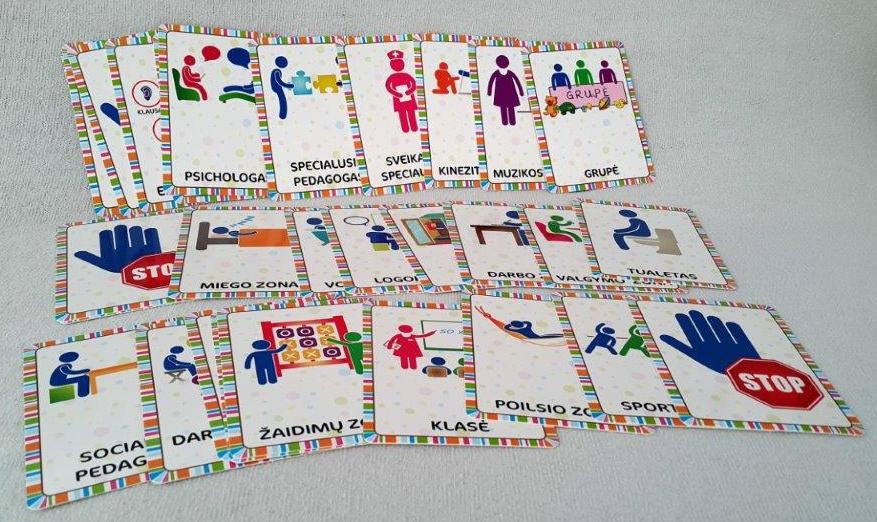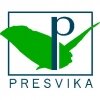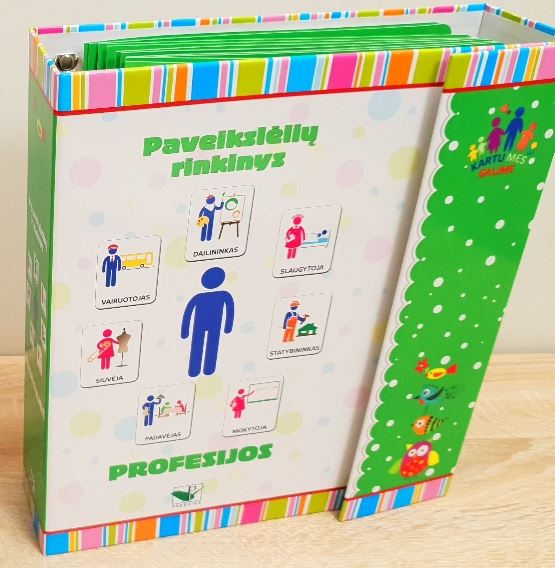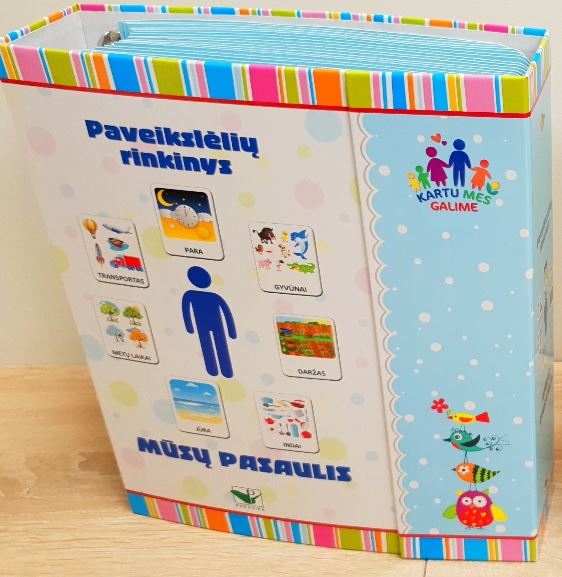For teachers and parents of children with autism spectrum disorders, language and communication disorders and other developmental delays
-
Publishing house Presvika, in association with Margarita Jureviciene and Toma Jokubaitiene, has prepared two sets of communication pictures for teachers and parents of children with autism spectrum disorders, language and communication disorders and other developmental delays.
Set No. 1 "Communication in Pictures" Set No. 2 "Learning through Pictures. Occupations. The Wolrd Around Us"
Interested in buying?
Set No. 1 "Communication in Pictures"
A set of communication pictures "Communication in Pictures" (by Margarita Jureviciene and Toma Jokubaitiene) for children with special educational needs is a set of teaching materials for teachers and parents of children with autism spectrum disorders, language and communication disorders and other developmental delay. Professionals of the Center for Special Education and Psychology have included this set of teaching materials to the catalog of recommended special educational materials.
A set of communication pictures enables children and others with language and communication difficulties to successfully participate in social life, to adapt to different social situations (home, school other social environments), to deal with difficulties in an effective and constructive way.
This kit is good to use for a variety of groups: pre-school and school age children, children with special educational needs, as well as parents, special education teachers, speech therapists, social educators.
Contents of the teaching material set:1. Pictures for dividing the home environment into activity zones. Labeling space for its purpose (work zone, play zone, etc.) makes it easier for the child to navigate in the environment. (32 cards)
Certain zones make it easier for the child to navigate in the environment (ex. bathroom door is labeled BATHROOM, another picture is used for play or other activity zone, etc.). The purpose of labeling (work zone, play zone, etc.) makes it clear to the child where to work and the boundaries of each zone.
2. Individual schedule, daily activities schedule posters. A creatively presented schedule allows the child to see and know what, where and when activities are going to happen, this helps a child feel safe and overcome anxiety. (A3, 2 pieces)
A visual schedule allows the child to see and know what, where and when happens in the future, what is done next. The child understands what the lesson comes next, knows that the break follows, when is the time for eating and so on. When the change in order of activities is expected, parents or teachers warn the child, giving him / her time to understand and prepare for the change. The end of an activity is emphasized by removing the picture card. Understanding the meaning of the visual schedule, the child develops a skill of using a visual schedule system that can be used in a new unstructured environment. The clarity of the sequence of events of the day gives a child a sense of security and helps him / her deal with anxiety. It is important to include activities that the child avoids, such as playing with friends, reading a book and so on., followed by rewarding activities.
3. Posters for behavior rules and recommended activities. These picture cards and the token economy systems will help the child to successfully communicate, achieve goals, get along with others. (32 picture cards, 16 star picture cards, 1 A3 poster, 1 A4 poster)
These picture cards will help the child to successfully communicate at home and at school, to achieve their goals, to get along with others, to feel safe. Parents or teachers choose the reward (or the child choses himself) based on the problem behavior. He / she is rewarded for showing the appropriate behavior. It is important to determine how many stars a day or week a child must earn for following the set rules or chores in order to receive the reinforcer. During the teaching stages, the expectations can be lower or rules easy to comply with so that the child is more willing to follow them as he or she experiences the joy of the reinforcer.
4. Fans of pictures of state, feelings, emotions, behaviors will help the child to express feelings, emotions, states and desires, understand others, and teachers to identify causes of anxiety. (2 pcs, two sided)
By showing the necessary picture, the child can express wishes and desires, to understand and be understood by others, and to share attention, experiences and troubles (e.g., "toothache" or "I'm hot", etc.). The Fans help parents and teachers easily identify and eliminate the causes of anxiety (such as too hot, too many people, etc.).
5. Keychains include a set of commonly used concepts and warning pictures to help the child regulate his or her own behavior and that of others, ask for help, answer questions, and so on. (2 pieces of 24 pictures, 1 piece of 16 pictures)
Keychains include pictures of commonly used words, as well as warning pictures for behavior management. Having them allows the child to control their own behavior and that of others, to summarize, to plan and to express their own ideas, intentions and actions (ex. asking for help, answering (yes/no) the question "Do you want ..."? , follow the instructions to fasten your seat belt, etc.).
6. Sequence Picture Cards breakdown complex activities into steps and help the child to successfully complete the task, developing self-service and self-management skills. (3 units)
Breaking down the activity into single steps helps the child successfully complete the task, developing self-service and self-management skills. In the beginning it is important to explain to the child the order of each action: to emphasize the sequence of intermediate actions, to point out essential features of each action. Posters of action sequence are to be placed in place where the child can easily see.
7. A pyramid is a teaching material that enables successful exchange of information with those around, learn how to form sentences, express your needs and desires. (1 pc)
This tool allows the successful exchange of information with those around, learn how to form sentences, express your needs and desires. For example, to show what activities your child needs to do (now – next, today), the pictures "WORK" (now) and "COMPUTER" (next) are displayed. Later on the child learns to expand sentences by adding verbs, adjectives, prepositions. For example, the pictures "RED" and "BALL" or the pictures "I", "WANT" and "APPLE" are sorted. It is important for the child to see and understand 1) what to do, 2) where to do it, 3) how long to do it, and 4) what happens afterwards.
8. A poster for reinforcing pictures (I want…) helps the child to express his / her desires and needs, encourage him / her to behave properly and with self-confidence, and serves as a prompt. (1 A3 poster + 16 picture cards)
The poster, which is places in a permanent place and is easily accessible to the child, also serves as a prompt. The poster contains pictures of basic needs (eg DRINK, EAT) as well as reinforcing object picture (ex. CHOCOLATE, DRESS, PHONE, GAME, etc.). It is important to identify the reinforcers that motivate the child to engage and complete the activity. Not only can these pictures be used in the teaching process when the child has to do exercises (ex. the child shows that he or she wants to watch TV, then the parents or teachers ask them to do a less favorite task or homework; or in order to encourage the child to engage in an appropriate behavior (such as he / she needs to use the toilet). The ability of independent expression of needs and desires is to be reinforced.
9. The binder "Home" consists of pictures depicting household objects and home activities. (304 pcs with velcro stickers + 16 blank cards)
The binder "HOME" consists of pictures of the most essential items in the home environment and actions at home, designed to learn new concepts, form sentences, and label the environment. The pictures are divided into HOME (general), KITCHEN, BATHROOM AND TOILET, CLOTHES.

10. The binder “EDUCATION INSTITUTION” contains pictures depicting the most necessary items, tools and actions in the learning environment, for teaching new concepts, forming sentences, labeling the environment. (256 pcs with Velcro stickers + 16 blank cards)


COMMUNICATION IN PICTURES is an innovative set of teaching materials for promoting the child's linguistic and emotional development. For children who, for a variety of reasons, have difficulty expressing themselves or understanding others, visual aids and communication pictures help to raise awareness of language and the environment, and facilitate communication. The visual information is easier for children to understand, so using visual elements not only makes it easier to communicate at home, in an educational institution or other social environment, it also enables them to enter into certain routines, avoid problem behaviors and give the child a sense of security.
The use of pictures not only develops language and understanding, but also the child's independence, ability to plan his or her time, and social skills. The child, who has learned to express his or her thoughts, is taught to follow the visual schedule. Using of the token economy system both at home and in the educational environment encourages motivation not only to behave properly, but also to perform tasks. Teaching with visual aids helps to achieve much better results because the abstract and complex concepts conveyed in the images are more easily understood, and the activity sequence pictures encourage the child to act independently and to become more confident. Planning of free time helps to avoid the stress of having difficulty of choosing an activity.For any further information, please contact us: info@presvika.lt
to the TOP!
Set No. 2 "Learning through Pictures. Occupations. The Wolrd Around Us"
A set of teaching materials “Learning through Pictures. Occupations. The World Around Us” (Sequel of the teaching materials’ set Communication in Pictures) is designed to teach a child's skills of focusing attention, ability to compare objects, identify similarities and differences, and systematize and summarize information. It is recommended that you use picture cards from both sets when doing these exercises.
The exercises will help to acquire the skills needed to learn reading, writing and counting, promote language development and speaking fluency, and expand vocabulary. The exercises are presented in such a way that within the exercise, a teacher and a student can develop a conversation and at the same time improve the fluency of speech and language. The multifunctional nature of the materials for exercises will open opportunities for playful learning, understanding of the surrounding environment, coherent expression of thoughts, time management. Sticking and unsticking the picture cards will help to improve fine motor skills.
Specialists of the Center for Special Education and Psychology have added this set of teaching materials to the catalog of recommended materials in special educational teaching.
Conceptual basis and structure of the teaching material set. The present teaching material set is based on the holistic education concept, which allows to create preconditions for the development of cognitive, emotional, social and health care competences.Depending on the individual needs of each child, the educational opportunities and the immediate environment, knowledge and experience available, different competences can be developed in an integral way, i.e. linking several interrelated skills (cognitive, language) with the development of social, emotional and / or health care competences. A variety of meaningful and engaging exercises that match individual abilities of attention, comprehension, cognitive, socio-cultural experiences, and special educational needs allow each child to succeed in learning.
Teaching guidelines. The teaching materials’ set will increase stimulation of the child's active cognitive skills (analyzing, comparing, generalizing, understanding cause and effect, problem solving) and language (concepts and labeling, expanding of vocabulary, coherent language, etc.).
Exercises designed to develop cognitive skills will help a child learn of labeling objects and abstract concepts in the environment, of recognition of the functions of objects presented in pictures, of categorizing objects by common features (color, shape, size, number), to identify similarities and differences, to summarize, to determine cause and effect relationships.
Language development skills – the child should be encouraged to use appropriate words and concepts to express his or her knowledge and experiences: labeling objects, phenomena, people, actions and characteristics, identifying a graphic image, recognizing sounds, letters and syllables, writing letters and words, language comprehension, ability to ask a comprehensive and accurate questions, ability to point out what was learned, express personal opinion, and so on.
The exercises presented in the teaching guide are recommendations. It is highly recommended to use the teaching materials’ set flexibly and with imagination. Exercises can be presented in different ways depending on the child's individual skills and needs. Here are some examples of how to organize and present the exercises. The teacher lines the picture cards (e.g., rabbit, beetle, soldier, balloon, snail, boy, airplane), and the child identifies modes of movement (rabbit leaps, beetle creeps, soldier hikes, balloon rises, snail creeps, boy runs, plane flies, etc. .). Health care competence exercise: the teacher selects pictures (e.g.: fire, book, pencil, scissors, knife) and the child has to identify and explain which items in the pictures are dangerous.
Depending on the individual needs of the child, the portable card stripe can be used to make the following:
- schedule. The child can carry it around so that it is clear what activity comes next. For example, the morning routine: getting up, making the bed, washing the face, brush teeth, having breakfast, going to school on a school bus, etc.;
- a personal schedule, for ex. today at school: orientation activities, cognitive activities, communication activities, physical education; or: mathematics, Lithuanian, cognition of the world, art, physical education, speech therapy, massage etc.
- a sequence of actions or events, such as if the child has to take care of the dog at any time of the day, cards such as "feed the pet", "play with the pet", "walk the dog", "bathe the pet" can be used; Cards such as "dressing up", "panties", "underwear", "shirt", "socks", "pants", "slippers", etc. may be used to indicate the sequence of dressing.
- A list of materials needed for a lesson, for ex. art lesson: drawing paper, brush, gouache, apron, water jar, palette, chalk. With the list, the child is getting ready for lesson during the break independently.
- Shopping list for shopping, ex. Need to buy: milk, bread, baton, water, curd, etc.
- A visual prompt, for example, that it is important to bring sportswear and sportswear to school tomorrow.
- social history, such as choosing a picture of a cafe when getting ready to go out to a cafe, then a series of action pictures: "waiter", "ordering", "menu", "eating at the table", "good job", etc.;
- a task with a time frame, ex. 20 minutes for bath, a display the timer card and a "bathing" card. A timer is used together.
Pre-school and school age children can use the 'Learning through Pictures’ and 'Communication in Pictures' sets of teaching materials, based on their individual needs. Functional teaching materials are easy to use in any environment (home, school, hairdressing, park, cafe, etc.) that helps children of all levels learn to express their needs, understand the environment, interact with people, understand and memorize sequence of events, behave appropriately, complete given tasks.
All of this allows children to develop independence, develop a variety of cognitive abilities as well as help reduce their anxiety.
Contents of the teaching material set:
Binder “Professions” – 150 picture cards.
Binder “The World around Us” – 300 picture cards.Set of picture cards “Timer” – 16 picture cards and set of picture cards “Calming down materials” - 16 picture cards.

4 platforms for exercises – 3 (A4) and 1 (297x85mm)

Writing board (A4)
4 color markers, erasing pad, write and wipe pocket (A4), worksheets (20, A4)

Portable line for picture cards (folded 280x70mm)

Teaching guideFor any further information, please contact us: info@presvika.lt
to the TOP!





